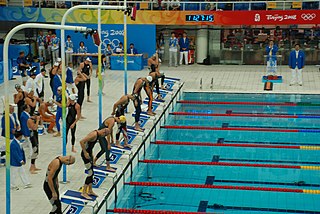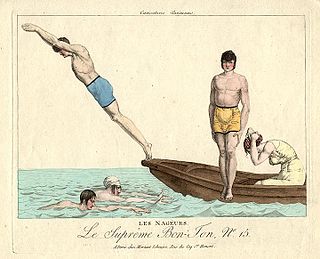
A bikini is a two-piece swimsuit primarily worn by women that features one piece on top that covers the breasts, and a second piece on the bottom: the front covering the pelvis but usually exposing the navel, and the back generally covering the intergluteal cleft and some or all of the buttocks. The size of the top and bottom can vary, from bikinis that offer full coverage of the breasts, pelvis, and buttocks, to more revealing designs with a thong or G-string bottom that covers only the mons pubis, but exposes the buttocks, and a top that covers only the areolae. Bikini bottoms covering about half the buttocks may be described as "Brazilian-cut".

A swimsuit is an item of clothing designed to be worn by people engaging in a water-based activity or water sports, such as swimming, diving and surfing, or sun-orientated activities, such as sun bathing. Different types may be worn by men, women, and children. A swimsuit can be described by various names, some of which are used only in particular locations or for particular types of suit, including swimwear, bathing suit, bathing attire, swimming costume, bathing costume, swimming suit, swimmers, swimming togs, bathers, cossie, or swimming trunks, besides others.
Speedo International Limited is an Australian-British distributor of swimwear and swim-related accessories based in Nottingham, England.

A one-piece swimsuit most commonly refers to swimwear worn primarily by women and girls when swimming in the sea or in a swimming pool, playing water polo, or for any activity in the sun, such as sun bathing. Today, the one-piece swimsuit is usually a skin-tight garment that covers the torso, although some designs expose the back or upper chest.

Markus Antonius Rogan is a retired Austrian swimmer, who won two silver medals at the 2004 Summer Olympics in Athens, Greece and a gold medal for 200 m backstroke at the 2008 World Short Course Championships in Manchester. He also was the world record holder in 200 metres backstroke in that year.

Competitive swimwear refers to the swimsuit, clothing, equipment, and accessories used in the aquatic sports of swimming, diving, artistic swimming, triathlon, and water polo.

Arena S.p.A. is an Italian manufacturing company of competitive swimwear created in 1973 by Horst Dassler. The company is currently headquartered in Tolentino, Italy. In 1990, Arena was sold by Adidas to Japanese corporation Descente Ltd., which still commercialises its products.
High-technology swimwear, or tech suits, are scientifically advanced materials used for swimwear in competitive water sports such as swimming and triathlon. Materials of this type are normally spandex and nylon composite fabrics with features to reduce drag against the water. The fabrics include features that increase the swimmer's glide through water and reduce the absorption of water by the suit as opposed to regular swimsuits. Additionally, the suits are extremely tight, which make the swimmers body more streamlined and help reduce the buildup of lactic acid in the body. Since 2010, high-tech swimsuits, specifically those offering significant performance-enhancing features and made from non-textile materials, have been banned in professional competitive swimming. This decision was made by FINA after the 2008 and 2009 swimming seasons, during which many world records were broken by swimmers wearing high-tech swimsuits, raising concerns about the impact of technology on the sport.
The 2009 World Aquatics Championships or the XIII FINA World Championships were held in Rome, Italy from 18 July to 2 August 2009. This was the second time the championships were held in the city after being previously hosted in 1994.
The swimming competitions at the 2008 Summer Olympics took place from 9 to 17 August 2008 at the Beijing National Aquatics Centre. The newly introduced open water marathon events (10 km) were held on 20 and 21 August 2008 at Shunyi Olympic Rowing-Canoeing Park.

A burkini is a style of swimsuit for women. The suit covers the whole body except the face, the hands, and the feet, while being light enough for swimming. This type of swimwear was designed with the intention of creating swimwear for Muslims who observe hijab in this way. The amount of skin covered is about the same as the person wearing a full body wetsuit and a swimming cap.

A swim brief or racing brief is any briefs-style male swimsuit such as those worn in competitive swimming, diving and water polo. The popularity of the Australian Speedo brand racing brief has led to the use of its name in many countries around the world to refer to any racing brief, regardless of the maker. Occasionally, the speedo genericized trademark is applied to square cut swimsuits, but in general the generic term is used in reference to swimming briefs. Swim briefs are also referred to as competition briefs, swimming trunks, bathers, togs, racer bathers, posing briefs, racing briefs, and colloquially in Australia, New Zealand, and the United Kingdom as budgie smugglers.

Swimming is an individual or team racing sport that requires the use of one's entire body to move through water. The sport takes place in pools or open water. Competitive swimming is one of the most popular Olympic sports, with varied distance events in butterfly, backstroke, breaststroke, freestyle, and individual medley. In addition to these individual events, four swimmers can take part in either a freestyle or medley relay. A medley relay consists of four swimmers who will each swim a different stroke, ordered as backstroke, breaststroke, butterfly and freestyle.
The 2008 Summer Olympics in Beijing saw more World records broken than any Olympic Games before. Numerous new Olympic records were further set.

Arena X-Glide is a swimsuit from the Arena brand, made of pure polyurethane that causes a swimmer to slide through water faster when swimming. One notable example of the efficacy of this suit design is that of Paul Biedermann of Germany who wore the suit in the 2009 World Championships, breaking two world records. The design of the suit covers basically the whole torso and the legs with the impermeable polyurethane, thereby exposing less skin to the water and improving the swimmer's buoyancy and streamlined shape. This significantly reduces the drag on the swimmer as they move through the water.

AgonSwim is a competitive swimwear manufacturer company based in Nashville, Tennessee. AgonSwim was founded by and is run by former competitive swimmers Rafael Escalad, Henar Alonso-Pimentel, Jennifer Edson Escalas and Juan Enrique Escalas. The company was incorporated in 2000 and specialises in producing and manufacturing swimsuits in Valladolid, Spain for swimmers, water sport athletes, lifeguards and divers.
Technology doping is the practice of gaining a competitive advantage using sports equipment. The World Anti-Doping Agency (WADA) considers prohibiting technologies if they are "performance-enhancing" or "being against the spirit of the sport". In 2006, WADA initiated a consultation on technology doping which is now officially recognised as a threat, whilst the decision to allow or ban a new technology, specifically relating to sports equipment, is the responsibility of each sport’s own governing body.

The history of competitive swimwear has been dominated by concerns over public nudity in the first half of the 20th century and by efforts to reduce water drag in the second half. Those efforts initially led swimmers to reduce the early sagging one-piece swimsuits down to briefs only. With the development of new materials that tightly fit the body and offered lower resistance to water than human skin, this trend was reversed to a complete body coverage from heels to neck and wrists. FINA banned full-body suits from competition effective from 1 January 2010, stating that it "wishes to recall the main and core principle is that swimming is a sport essentially based on the physical performance of the athlete".
Bruce Robert Mason OAM is a leading Australian sports scientist in the field of biomechanics. Between 1982 and 2014, he made a significant contribution to the Australian Institute of Sport (AIS) in the area of biomechanics, particularly in the sport of swimming.

The history of swimwear traces the changes in the styles of men's and women's swimwear over time and between cultures, and touches on the social, religious and legal attitudes to swimming and swimwear.














